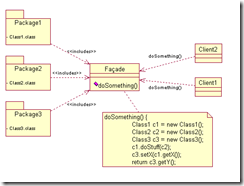好吧,又见到这个模式了。。
在项目中,这个模式被用来构建整个system,作为对外交互的接口,这是facade的擅长的。
A facade is an object that provides a simplified interface to a larger body of code, such as a class library. A facade can:
- make a software library easier to use, understand and test, since the facade has convenient methods for common tasks;
- make code that uses the library more readable, for the same reason;
- reduce dependencies of outside code on the inner workings of a library, since most code uses the facade, thus allowing more flexibility in developing the system;
- wrap a poorly-designed collection of APIs with a single well-designed API (as per task needs).
An Adapter is used when the wrapper must respect a particular interface and must support a polymorphic behavior. On the other hand, a facade is used when one wants an easier or simpler interface to work with.
上图,from wiki:
上代码:
* Complex parts */
class CPU {
public void freeze() { ... }
public void jump(long position) { ... }
public void execute() { ... }
}
class Memory {
public void load(long position, byte[] data) { ... }
}
class HardDrive {
public byte[] read(long lba, int size) { ... }
}
/* Facade */
class Computer {
private CPU cpu;
private Memory memory;
private HardDrive hardDrive;
public Computer() {
this.cpu = new CPU();
this.memory = new Memory();
this.hardDrive = new HardDrive();
}
public void startComputer() {
cpu.freeze();
memory.load(BOOT_ADDRESS, hardDrive.read(BOOT_SECTOR, SECTOR_SIZE));
cpu.jump(BOOT_ADDRESS);
cpu.execute();
}
}
/* Client */
class You {
public static void main(String[] args) {
Computer facade = new Computer();
facade.startComputer();
}
比较简单,就不解释了
